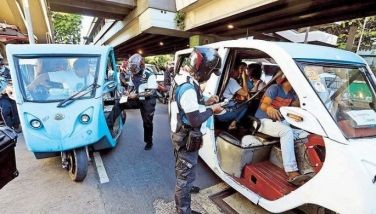Law changing Maguindanao's capitol pushed
COTABATO CITY, Philippines - Maguindanao’s communities on Wednesday unanimously endorsed a proposed ordinance naming Buluan as permanent seat of the province to put closure to a dilemma hounding local folks for four decades now.
The proposal, aiming to establish a permanent provincial capitol in Buluan town in the second district of the province, was tackled extensively during a three-hour public hearing in Buluan town Wednesday, presided over by members of the Sangguniang Panlalawigan (SP).
The hearing was participated by leaders of different sectors, including local executives, representatives of the local senior citizens group, retired policemen, soldiers and public school teachers.
The discussions were repeatedly punctuated by cheers and applause as speakers and reactors, among them businessmen, Moro lawyers and members of the academe, expressed support to the establishment of a new provincial capitol in Buluan.
Gov. Esmael Mangudadatu was also present in the public hearing to hear the arguments and suggestions from sectoral representatives that deliberated for three hours on the positive socio-economic and political effects of the proposal.
The public hearing was jointly led by senior members of the provincial board, among them Russman Sinsuat, Jr., Asnawi “Jojo†Limbona, and Bobby Katambak. Sinsuat represented his elder, Maguindanao Vice-Gov. Lester Sinsuat in the dialogue, meant to gather public imprimatur for the proposed ordinance.
“We don’t have any opposition to it. We want a strong semblance of governance, or a basic icon of strong governance to rise in the province,†said Lucia Cueto-Sinsuat, chair of the Federation of Maguindanao’s Senior Citizens Organizations and widow of Michael “Datu Puti†Sinsuat, who had served as mayor of North Upi, Maguindanao for three consecutive terms.
Most participants to the hearing argued that Buluan is indeed the most appropriate spot where the provincial capitol should be, owing to its being near to the capitals of the provinces of Sultan Kudarat, North Cotabato and South Cotabato.
The territories of the adjoining Maguindanao, Sultan Kudarat, North Cotabato and South Cotabato were carved from the historic 19th century “Empire Province of Cotabato,†which was split into four provinces in Nov. 22, 1973 by then President Ferdinand Marcos via Presidential Decree (PD) 341.
The provincial capitol of the now defunct empire province, whose jurisdiction spanned from what are now North Cotabato’s Makilala town, up to Gen. Santos City, originally named Buayan municipality, and to the southwestern coasts of Sarangani province, was in Pagalungan, hometown of one of its pioneering governor, the late Datu Udtog Matalam, Sr., who had served from after World War II until shortly before the declaration by President Marcos of the Martial Law on Sept. 21, 1972, also known as PD 1081.
The partition of the empire province into three smaller provinces was part of an effort by Marcos to quell the Moro uprising then by creating more local government units to accommodate revolting Moro leaders and engage them in governance to help spur economic growth and political stability in areas affected by secessionist conflicts.
Marcos had stated in PD 341 that the capital of Maguindanao was Maganoy, now named Shariff Aguak, hometown of the Ampatuans, which ruled the province from 2001 to 2009 with absolute intolerance for political opposition.
The Ampatuans, while at the helm of the provincial leadership, built a P120 million provincial capitol about two years before the Nov. 23, 2009 infamous Maguindanao Massacre, or thereabouts, which led to the incarceration and on-going prosecution of clan leaders for their alleged involvement in the atrocity.
Education Secretary Armin Luistro and Mangudadatu, who was first elected Maguindanao governor in 2010, agreed last week, during a meeting in Cotabato City, to convert into a public school the now mothballed, 6,000-square meter, three storey capitol building in Shariff Aguak, once an icon of the political clout of the Ampatuan family.
The Ampatuans forged ahead with the construction of the plush provincial capitol in Shariff Aguak despite President Marcos’ PD 1170, promulgated July 11, 1977, that explicitly transferred the capitol site from Shariff Aguak, then known as Maganoy, to Sultan Kudarat town in the first district of the province.
The provincial capitol site was returned to Shariff Aguak via Batas Pambansa 211, issued by the Batasang Pambansa, dated March 25, 1982, supposedly through a plebiscite, that was, for unknown reasons, was never administered.
Members of the provincial board had told reporters they will consolidate the recommendations and statement of support by participants to Wednesday’s public hearing in Buluan into one “reference book†as basis for promulgation of an ordinance naming Buluan as new seat of the provincial government.
The board members had emphasized, however, that the ordinance would have to be approved through a voting procedure by members of the Sangguniang Panlalawigan.
An ex-officio member of the SP, Adnan Biruar, president of the Association of Barangay Captains in Maguindanao, said the bloc he represents, whose members are scattered across the 36 towns in Maguindanao, are in favor of the proposal.
- Latest
- Trending































